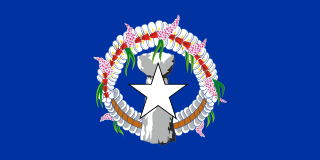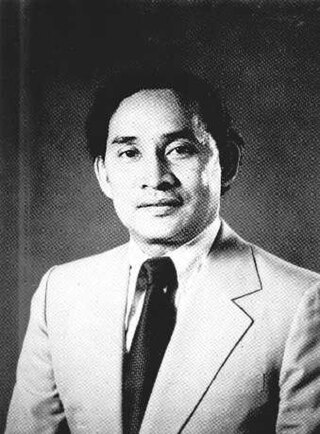 |
|---|
A constitutional referendum was held in the Northern Mariana Islands on 6 March 1977. [1] The new constitution was approved by 93% of voters and came into force on 9 January 1978. [1]
 |
|---|
A constitutional referendum was held in the Northern Mariana Islands on 6 March 1977. [1] The new constitution was approved by 93% of voters and came into force on 9 January 1978. [1]
A Constitutional Assembly had been elected and drafted the new constitution between 18 October until 5 December 1976. [1]
| Choice | Votes | % |
|---|---|---|
| For | 3,557 | 93.24 |
| Against | 258 | 6.76 |
| Invalid/blank votes | 19 | – |
| Total | 3,834 | 100 |
| Registered voters/turnout | 6,554 | 58.50 |
| Source: Direct Democracy | ||

The Northern Mariana Islands, officially the Commonwealth of the Northern Mariana Islands, is an unincorporated territory and commonwealth of the United States consisting of 14 islands in the northwestern Pacific Ocean. The CNMI includes the 14 northernmost islands in the Mariana Archipelago; the southernmost island, Guam, is a separate U.S. territory. The Northern Mariana Islands were listed by the United Nations as a non-self governing territory until 1990.

The flag of the Commonwealth of the Northern Mariana Islands was adopted in July 1, 1985 by the Second Northern Marianas Constitution. The NMI flag was originally designed during the year 1985. Later during that year, they finalized the draft of the flag in the last CNMI constitutional convention.

Territories of the United States are sub-national administrative divisions overseen by the federal government of the United States. The various American territories differ from the U.S. states and Indian reservations as they are not sovereign entities. In contrast, each state has a sovereignty separate from that of the federal government and each federally recognized Native American tribe possesses limited tribal sovereignty as a "dependent sovereign nation". Territories are classified by incorporation and whether they have an "organized" government through an organic act passed by the Congress. American territories are under American sovereignty and, consequently, may be treated as part of the United States proper in some ways and not others. Unincorporated territories in particular are not considered to be integral parts of the United States, and the Constitution of the United States applies only partially in those territories.
Commonwealth is a term used by two unincorporated territories of the United States in their full official names, which are the Northern Mariana Islands, whose full name is Commonwealth of the Northern Mariana Islands, and Puerto Rico, which is named Commonwealth of Puerto Rico in English and Estado Libre Asociado de Puerto Rico in Spanish, translating to "Free Associated State of Puerto Rico." The term was also used by the Philippines during most of its period under U.S. sovereignty, when it was officially called the Commonwealth of the Philippines.
In the United States, each state has its own written constitution.

The 2005 Northern Mariana Islands general election was held on Saturday, 5 November 2005. Voters in the Northern Mariana Islands voted for the Governor of the Northern Mariana Islands, the non-voting delegate to the United States House of Representatives, attorney general, 6 seats in the Northern Mariana Islands Senate, all eighteen seats in the Northern Mariana Islands House of Representatives, 3 mayors, seats for the municipal council, seats for the board of education, 2 justices, and a judges. There was also a referendum on calling a Constitutional Convention, which was approved by voters.
This electoral calendar 2005 lists the national/federal direct elections held in 2005 in the de jure and de facto sovereign states and their dependent territories. Referendums are included, although they are not elections. By-elections are not included.
The Constitution of the Commonwealth of the Northern Mariana Islands is the governing document of the United States Commonwealth of the Northern Mariana Islands ("CNMI"). Its creation was required by the covenant between the United States and the CNMI. It was drafted at a local constitutional convention in 1976, approved by territorial voters in a referendum on March 6, 1977, and became effective January 9, 1978.

The Northern Mariana Islands Commonwealth Legislature is the territorial legislature of the U.S. commonwealth of the Northern Mariana Islands. The legislative branch of the territory is bicameral, consisting of a 20-member lower House of Representatives, and an upper house Senate with nine senators. Representatives serve two-year terms and senators serve four-year terms, both without term limits. The territorial legislature meets in the commonwealth capital of Saipan.

Carlos Sablan Camacho is a Northern Mariana Islander politician who served as the first governor of the Northern Mariana Islands from January 9, 1978, to January 11, 1982.

A referendum on holding a Constitutional Convention was held in the Northern Mariana Islands on 5 November 1983. The proposal was approved by voters. A subsequent 44-part referendum on constitutional amendments was held in 1985.

A constitutional referendum was held in the Northern Mariana Islands on 2 November 2010, alongside the election for the islands' representative to the United States House of Representatives. Voters were asked whether they approved of three proposed amendments to the constitution. All three were rejected.

A three-part referendum was held in the Northern Mariana Islands on 6 November 1993. Voters were asked whether they approved of two constitutional amendments regarding collective land ownership of native islanders and the veto powers of the Governor, and whether a Constitutional Convention should be elected. All three proposals were approved by voters.

A constitutional referendum was held in the Northern Mariana Islands on 6 November 1995. Voters were asked whether they approved of two proposed amendments to the constitution; one limiting the rights to vote on constitutional amendments that affected land ownership to native islanders, and one on establishing an Office of Finance to regulate the spending of the Legislature. The first proposal was approved by voters and the second rejected.
A constitutional referendum was held in the Northern Mariana Islands on 6 November 2012, alongside the election for the islands' representative to the United States House of Representatives. Voters were asked whether they approved of three proposed amendments to the constitution. All three were approved.

The 2014 Northern Mariana Islands general election were held on Tuesday, 4 November, 2014. The election coincided with the 2014 United States midterm elections. Voters in the Northern Mariana Islands voted for the Governor of the Northern Mariana Islands, the non-voting delegate to the United States House of Representatives, attorney general, 6 seats in the Northern Mariana Islands Senate, all twenty seats in the Northern Mariana Islands House of Representatives, 4 mayors, seats for the municipal council, and seats for the board of education. Additionally, a referendum involving changes to the constitution was held.
Article I, Section 12 of the Constitution of the Northern Mariana Islands states that "abortion of the unborn child during the mother’s pregnancy is prohibited in the Commonwealth of the Northern Mariana Islands, except as provided by law." No law has been passed legalizing abortion in the Northern Mariana Islands. Instead, Northern Mariana Islands criminal law states that performing an abortion is a crime punishable by up to five years imprisonment.

A nineteen-part referendum was held in the Northern Mariana Islands on 2 March 1996. Voters were asked whether they approved of constitutional amendments of each chapter, with a separate vote on each. All amendments were rejected.
The Marianas archipelago of the Northern Pacific contains fourteen islands located between Japan and New Guinea on a north–south axis and Hawaii and the Philippines on an east–west axis. Inhabitants were Spanish nationals from the 16th century until the Spanish–American War of 1898. As Guam became a territory of the United States the Northern Marianas were sold to Germany in 1899. The Northern Mariana Islands were a German protectorate until 1919, when they became part of the South Seas Mandate, administered by Japan. At the close of World War II, the Marianas became part of the Trust Territory of the Pacific Islands. In 1975, the Commonwealth of the Northern Mariana Islands became a self-governing territory. In 1986, the Marianas came under the sovereignty of the United States when the trusteeship ended and US nationality and citizenship was conferred on the inhabitants of the territory.